The Head Start Designation Renewal System (DRS) is an accountability system to ensure Head Start/Early Head Start (HS/EHS) grantees are delivering high-quality and comprehensive services. The DRS system has been successful in supporting quality improvement as Head Start grantees have engaged in a wide range of quality-improvement activities. Still, the DRS is often perceived as a crisis. Rahm Emanuel noted, “You never want a serious crisis to go to waste. And what I mean by that is an opportunity to do things you think you could not do before.” The DRS, the need to recompete for continued funding is a call to action. It provides the push to plan, evaluate, and implement a better program.

Writing the DRS Proposal
Cathleen Armstead, Ph. D.
The DRS process is complicated, and it requires a commitment to program improvement along with a thoughtful, well-crafted grant proposal that highlights the strengths of the program and the strategies for improvement. Hiring a skilled grant writer with experience in DRS proposals may be a wise investment. However, an overview of the process and the grant requirements will be helpful.
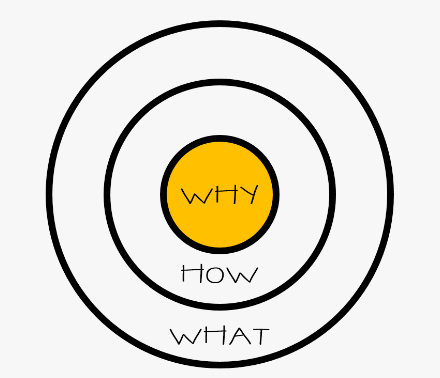
Start with your why
Simon Sinek advises us to always begin with the “why.” When writing your DRS grant, you will need to know your “why.” Why do you care? What is your purpose? What is your reason for providing HS/EHS services? Why you? Why now? Beginning with the “why” may take an investment of time and energy, but to move forward, there needs to be a consensus on “why.” Some examples of overarching goals that are connected to a program’s passion include the following:
To create a culture of lifelong learning among children (birth to five), families, and staff.
To foster a warm, welcoming place that is healthy, safe, and environmentally sustainable.
To create efficiencies and reduce duplication of effort through focused technology plans and processes.

Your planning process will outline the “how”. How will you work to further your goals? The budget is the foundation for building your program. Begin program planning with the budget. The “what,” in this case, is the program services. Beginning with the “why” and moving through the “how” of the budget will facilitate the delivery of program services.
Typically, a DRS grant proposal has seven sections. To evaluate the proposal, reviewers consider the extent to which the applicant demonstrates plans, processes, pathways to improvement, and measures of the strategies throughout each of the seven sections. Show don’t tell.

Section 1: Community Needs
A discussion of community needs, and strengths relies on a current Community Needs Assessment, or at least current data and descriptions of the community. The community assessment data provide the context in which HS/EHS programs operate. The Community Assessment paints a picture of the community and provides the context in which the HS/EHS program operates.
The Community Toolbox is an excellent resource for completing a community assessment. The description of the community will include information from secondary sources (statistics), focus group interviews, and surveys. Since HS/EHS is an anti-poverty program, the data describe poverty and income statistics. Other aspects of the data include age, gender, race and ethnicity, national origin, citizenship status, language, health conditions, and violence in the community or home.
The key to an excellent DRS proposal is connecting services to the needs of the community.
Where there is a high concentration of immigrant families, highlight connections with immigration lawyers and the strengths of your dual-language curriculum.
Where there is a high number of teenage pregnancies, highlight high school recruitment strategies and describe a Prenatal Academy.
Where there is a high rate of homelessness, document the strategies used to recruit and assist families in gaining shelter and discuss partnerships.

Section 2: Providing High Quality Services
The second section examines how the program will provide and improve services to children, families, and communities. Reviewers examine the ability of the HS/EHS program to implement a comprehensive, high-quality program. The proposal will highlight the strengths of the program and emphasize any improvements implemented and planned.
The sub-questions within section two need to be addressed thoroughly in approximately 15 pages. Too short indicates the questions were not sufficiently answered; too long exceeds the maximum of 75 pages for the narrative. The proposal will respond to each sub-question and describe:
Research-based curriculum and teaching practices
Establishing school readiness goals and plans for assessment of these goals
The process of establishing school readiness goals with parents
The needs of children with disabilities
The needs of children in targeted populations (foster care, dual language learners, homeless families, and pregnant women)
Comprehensive health, mental health, nutrition, and oral health services
Process of observing and measuring teacher/child interactions
The assessment tool to aggregate child outcome data
Plan to coordinate with public and private entities for services
Early Head Start: Delivery of services to pregnant women, including post-pregnancy care and transitions to Early Head Start; transition to Head Start or another preschool program
Meaningful engagement of parents

Section 3: Past Performance
Within this section of the DRS proposal, the HS/EHS program evaluates past performance and provides evidence of the program’s history and experience in successfully providing high-quality early education and family services. This is a complex section and is the most difficult for many HS/EHS programs to write within the context of DRS. Begin, elaborate, and highlight the strengths of the program. Again, describe the improvements already implemented and those that are planned.
This section also addresses non-compliance, deficiencies, findings, or lower-than-optimum CLASS scores and requires a detailed improvement plan. The strengths, improvement plan, measures of impact, and preliminary successes will need to be contained in less than ten pages.
Begin with the strengths of the program. Transition to a discussion of deficiencies, non-compliances, and audit findings. The plan for improvement should be the focus of this section, including a discussion of under-enrollment. Above all, be specific and give examples. Evidence and data charts are particularly helpful for this section.
Suggested changes to improve classroom elements (CLASS and Code of Conduct):
Additional coaching and mentoring staff
Training for coaching and mentoring staff
Training for teachers
Visual cues (e.g., stop signs) for counting children
Substantial improvements to the classrooms, including curriculum kits and safe spaces
Suggested changes for other improvements:
Provide structured training with a consultant for the governing body and the Policy Council.
Ensure your fiscal staff is thoroughly trained. There are consulting organizations that provide fiscal training specific to Head Start/Early Head Start.
Invest in a high-quality fiscal and accounting software.
Implement training on your data management systems.
Make use of technology—scanners rather copy machines, electronic signatures, and access to the state immunization database. Use online applications and a parent communication app.

Section 4: High-Quality Staff
This section will examine how the program recruits, hires, trains, and retains high-quality staff. The narrative for this section should be no more than 10 pages. Tables can be used to condense essential information into an accessible format and an organizational chart can illustrate roles, responsibilities, and relationships.
Recruiting teaching staff for early childhood programs is difficult. A salary that is commensurate with the prevailing wage is a necessity. Recruitment can also advertise smaller classrooms, coaching staff, and support for children with challenging behaviors. If there is a specialized recruitment process—such as a partnership with a local university or community college—be sure to highlight it.
Describe efforts to create and maintain a positive workplace culture, with an emphasis on employee engagement; this will strengthen the proposal and make it unique. Indicate that your managers have had training in creating effective teams, intensive coaching or mentoring, and strengths-based leadership.
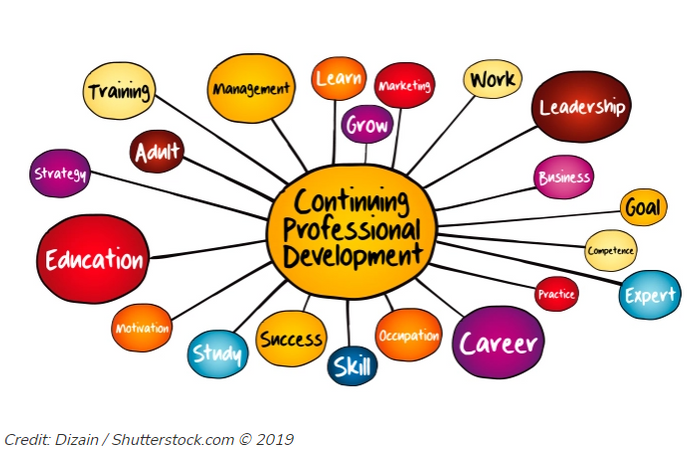
Professional Development
Be clear about the plan for professional development and ensure that it corresponds to the training budget. Focus efforts on sustained professional development that is tied to improving the program and reduce one-time workshops or conference travel.
Include a discussion of coaching and mentoring. All coaching and mentoring programs must be grounded in an evidence-based model and include opportunities to build rapport and create agreements, structured and unstructured observation by the coach, the provision of resources by the coach, reflection by the protégée, modeling by the coach, real-life practice in the classroom, and further reflection and observation.
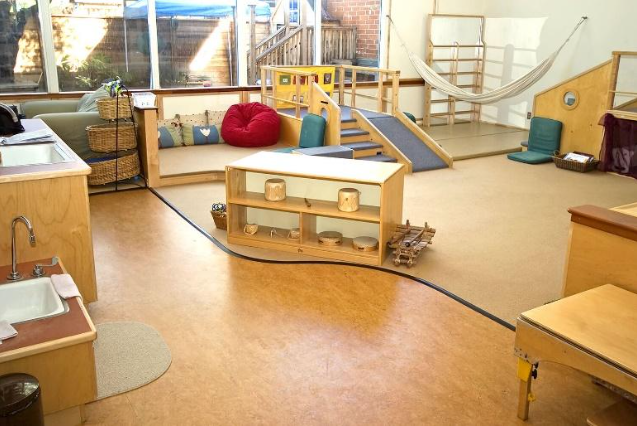
Section 5: Implementation Plan
A successful proposal will start services with a minimal start-up period; at the same time, a successful proposal provides for enough time to establish and implement a new or improved program. Representing the timeline with a visual graphic is effective for this purpose. The plan should include a discussion of facilities, particularly if these have been modified or improved. Further, the plan should reiterate how the HS/EHS program will recruit, hire, and train staff by the start of the program.
According to Louis Torelli, the architect and founder of Spaces for Children, the design of a classroom impacts its dynamics, and the physical environment affects children’s learning and development in many ways.
Well-designed environments support exploration, give young children a sense of control, and enable them to engage in focused, self-directed play. Every indoor activity area or learning center has a potential outdoor counterpart; an outside play area should be an extension of the classroom. The focus should be on providing excellent facilities to remove some of the conditions that lead to inadequate supervision or inappropriate disciplinary practices.
Timeline:
The following is an excerpt of a timeline. Work backward from your program start time. Notice how quickly time moves.
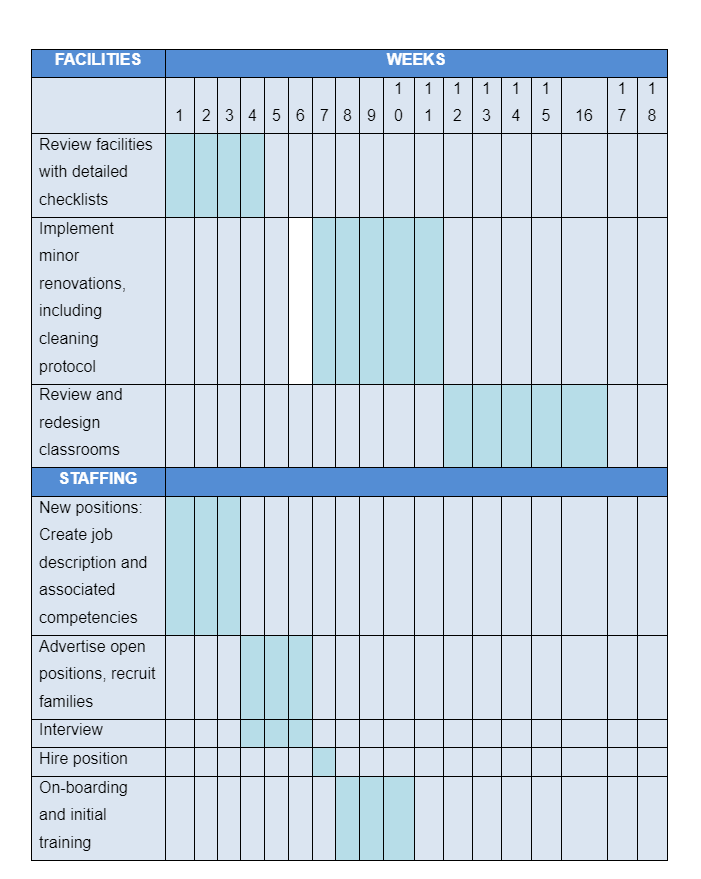
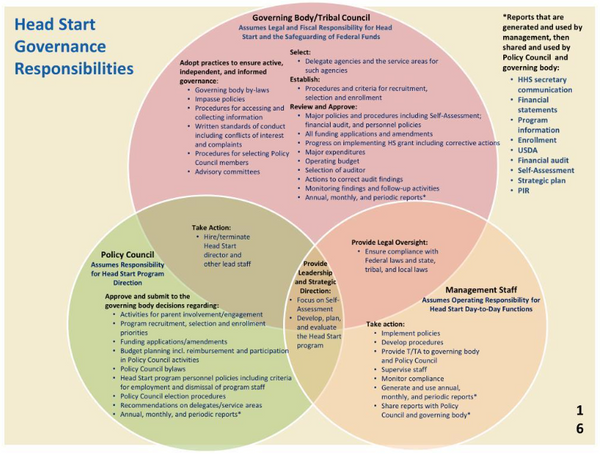
Section 6: Organizational Capacity and Governance
This section requires a discussion of the importance of the tripartite governance of HS/EHS programs: 1) the governing body; 2) the HS/EHS policy council; and 3) program leaders and managers. The section also includes a detailed discussion of effective oversight.
Describe the experience and accomplishments of leaders, managers, and direct service staff. Highlight those accomplishments that speak directly to oversight and accountability. Include formal education, credentials, and training, along with participation in local, state, regional, and national organizations. The experience of senior management staff should be commensurate with their responsibilities and compensation. Emphasize the cohesiveness of the management staff and clearly delineate their responsibilities.
Governing Body
The governing body has fiscal and legal responsibilities for the program. Outline each of the key members, including legal, fiscal, and early childhood development experts. Describe other governing body members and their contributions.
Emphasize expertise, commitment, and connection to the local community. Clarify how the governing body represents the community and its diversity in terms of race, gender, ability, and expertise.
Head Start Policy Council
Strategies for recruitment, training, and engagement of parents in the governance of the program need to be detailed in this section. A successful proposal might include how often quorum has been met and the effectiveness of training families on data literacy.
The three aspects of program governance (governing body, Policy Council, and program leaders) need to engage in consistent, regular, and structured communication that includes program, fiscal, and child outcomes. Monthly reports include demographics, enrollment, attendance, and meal counts. Importantly, monthly reports also include teacher/child interaction measurements, child outcome data, and monitoring results. Fiscal reports include the funds budgeted for each line item, expenditures, the balance, and an analysis of projections and variance. The budget must be detailed enough for fiscal experts to analyze yet comprehensible for parents. It is often helpful to present summaries first, followed by details.
Communication between the governing body and Policy Council can be easily accomplished through ensuring the Policy Council Chair is a voting member of the governing body, while a member of the governing body attends Policy Council meetings. Include the impasse procedure in the appendix.
Describe how the governing body, program leadership and key management positions, are representative of the diverse community in which they operate. Highlight connections with community organizations and ensure all racial and ethnic groups in your community are represented.
Describe the inclusive process of setting agency priorities. Indicate how the governing body, Policy Council, leadership team, and direct service staff participate in strategic planning sessions. Describe how the program eliminates barriers to participation such as the provision of childcare and meals during meetings. Emphasize how broad participation and a transparent process allow for effective goal setting.
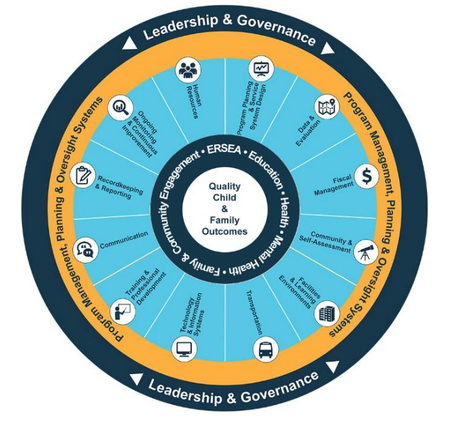
Management Systems
The last component of this section requests a complete description of management systems. Describe each of the 12 systems with a brief paragraph:
Leadership and governance
Fiscal management
Community and self-assessment
Training and professional development
Communication
Technology and information systems
Program planning and service design
Data and evaluations
Ongoing monitoring and continuous improvement
Recordkeeping and reporting
Facilities
Transportation (if applicable)
Section 7: Fiscal Proposal
The last section of your grant proposal explains and justifies the funds in your proposed budget and program narrative. A strong, supported, and well-written budget narrative is essential. The budget and budget narrative are worth a maximum of 20 points and will need to be contained within ten pages—tables can be single-spaced. The budget is the most important part of the grant and must be able to stand on its own. The budget must support the grant narrative by specifying the funding required for personnel, equipment, supplies, technology, and activities.
The budget narrative accompanies the budget (spreadsheets or tables), providing an item-by-item breakdown and demonstrating the necessity of each. The budget and budget narrative allow the reviewer to easily understand the costs of the applicant’s Head Start/Early Head Start program.
Clearly and accurately distinguish proposed Head Start and Early Head Start base operating funds, T/TA funds, total federal funds, and any non-federal funds. If start-up funds are asked for, these must be differentiated as well. The first table should delineate the 12-month annual operating budget.
The training and technical assistance plan needs to address the issues and concerns that led to the DRS. At a minimum, it should include costs for training coaches in a research-based model, training to engage the governing body and the Policy Council, training on curriculum and child outcomes, and training on the database management system.
Dr. Cathleen Armstead, the owner of Sunshine Nonprofit Solutions, provides strategic planning, consulting, and grant writing services to nonprofit organizations working with children and families. With twenty years of experience in the Head Start/Early Head Start world, she continues to advocate and work for social, economic and racial justice.
